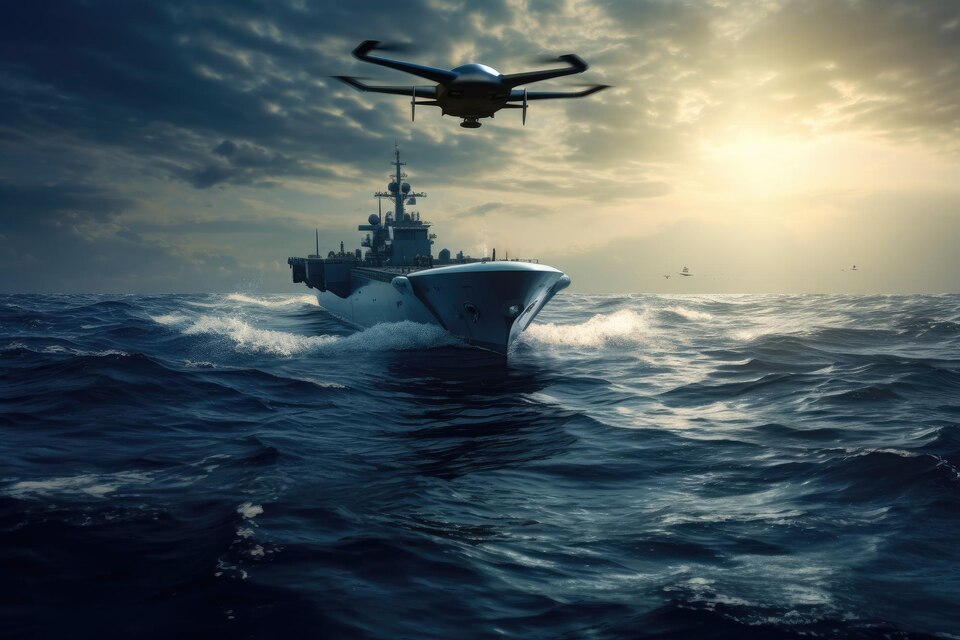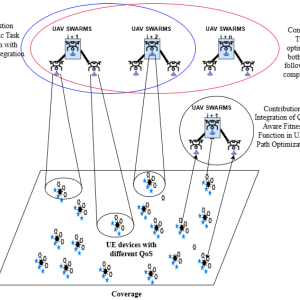In the ever-evolving world of defence and aerospace, technological advancements have always played a pivotal role in enhancing the capabilities of military forces. Among the many challenges that naval forces face, corrosion of their vessels stands out as a persistent and costly problem. The traditional methods of corrosion prevention and maintenance have proven to be time-consuming, expensive, and often insufficient. However, the dawn of the digital age has brought forth a groundbreaking solution that is set to Revolutionizing Naval Maintenance with AI-Powered Drones.

Introduction: Unveiling the Power of AI-Powered Drones
Corrosion poses a significant threat to naval vessels. Saltwater, constant exposure to harsh environmental conditions, and the wear and tear of naval operations take their toll on the structural integrity of ships. Traditional maintenance methods are labour-intensive and involve costly and time-consuming processes such as dry-docking, sandblasting, and repainting. These methods are not only expensive but also disrupt naval operations, leading to downtime and reduced readiness.
Enter AI-powered drones, a technological marvel that is set to change the game in naval maintenance. These drones are equipped with advanced sensors, machine learning algorithms, and autonomous capabilities, making them an invaluable tool for identifying, monitoring, and mitigating corrosion on naval vessels.
Key Benefits of AI-Powered Drones in Naval Maintenance
- Early Detection and Monitoring One of the most significant advantages of AI-powered drones is their ability to detect corrosion at an early stage. Equipped with high-resolution cameras and sensors, these drones can inspect the surface of a vessel with unparalleled precision. They can identify even the smallest signs of corrosion, such as surface pitting and rust formation, long before it becomes a significant problem.
- Reduced Maintenance Costs Traditional maintenance methods are not only time-consuming but also expensive. AI-powered drones can significantly reduce maintenance costs by pinpointing areas that require immediate attention. This targeted approach means that resources are allocated more efficiently, preventing unnecessary expenses.
- Enhanced Safety Naval maintenance often involves risky tasks, such as working at heights and in confined spaces. AI-powered drones can take on these dangerous tasks, reducing the risk to human personnel. This not only enhances safety but also ensures that maintenance can be carried out without putting lives in danger.
- Data-Driven Decision-Making The data collected by AI-powered drones is a goldmine for naval maintenance teams. The information gathered during inspections can be analyzed using machine learning algorithms to predict future corrosion trends, enabling proactive maintenance planning. This data-driven approach enhances decision-making and minimizes the risk of unexpected and costly repairs.
How AI-Powered Drones Work
AI-powered drones are equipped with an array of sensors, including ultrasonic, infrared, and visual cameras. These sensors work in synergy to provide a comprehensive overview of a vessel’s condition. The drones are programmed to follow a predefined flight path, ensuring that every inch of the vessel is thoroughly inspected.
The visual cameras capture high-resolution images, allowing for detailed visual inspection. Meanwhile, the ultrasonic sensors can measure the thickness of the vessel’s hull, detecting areas with reduced thickness, a common sign of corrosion. Infrared cameras are used to identify areas with unusual heat patterns, which could be indicative of structural issues.
Real-World Implementation
The impact of AI-powered drones in naval maintenance is not limited to theory; it has already made significant strides in practical application. Several navies around the world have embraced this technology, realizing its potential to transform maintenance operations. The United States Navy, for instance, has been at the forefront of integrating AI-powered drones into its maintenance strategy.
The USS Nimitz, one of the U.S. Navy’s aircraft carriers, has been a prime example of the successful implementation of AI-powered drones. These drones have been deployed to inspect the carrier’s hull and identify areas of corrosion. This proactive approach to maintenance has not only saved the Navy considerable time and money but has also extended the service life of the vessel.
Challenges and Future Developments
While AI-powered drones offer a promising solution to naval corrosion challenges, there are still challenges to overcome. One of the primary challenges is ensuring the reliability and accuracy of the data collected. Calibration of sensors and continuous improvement of machine learning algorithms are essential to maintain the effectiveness of these drones.
Additionally, there is a need for standardization in the use of AI-powered drones for naval maintenance. Clear guidelines and regulations must be established to ensure the safety and security of these systems.
As technology continues to advance, we can expect even more sophisticated AI-powered drones in the future. These drones may incorporate additional sensors, such as chemical analyzers, to provide even more comprehensive data on the condition of naval vessels. Furthermore, developments in AI and machine learning will result in more accurate predictions and proactive maintenance strategies.
Conclusion: A New Era in Naval Maintenance
The introduction of AI-powered drones into naval maintenance marks a new era in the defence and aerospace industry. These drones offer unparalleled precision, cost savings, enhanced safety, and data-driven decision-making. As we look to the future, it is clear that AI-powered drones will continue to revolutionize naval maintenance, extending the service life of vessels and ensuring the readiness of naval forces.
The technology showcased in this article is not only a game-changer for the U.S. Navy but also for navies around the world. As these drones become more sophisticated and widespread, naval maintenance will become more efficient, cost-effective, and safer. In the battle against corrosion, AI-powered drones have emerged as the ultimate solution, ensuring that naval vessels remain in optimal condition, ready to face any challenge on the high seas.










